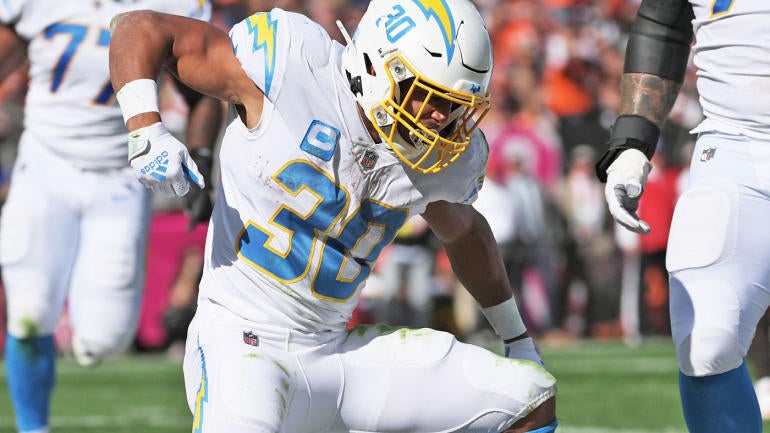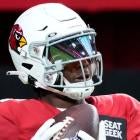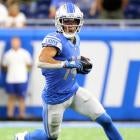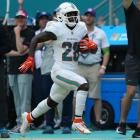
There's been this tug-of-war between rushers and receivers for Fantasy supremacy. For now, receivers are winning, which is why you'll see more non-running backs go in Round 1 than ever before, but that's true ONLY if your league counts receptions for anything.
On top of being kicked off the top of the mountain in PPR formats, a changing of the guard is happening at running back. Four of the top 10 RBs in my PPR rankings -- guys we've counted on for years -- are at least 27 years old (and Saquon Barkley is 26). This doesn't include prior stalwarts of the Fantasy galaxy like Aaron Jones, Alvin Kamara and Dalvin Cook, who aren't slam-dunk top-20 overall picks anymore.
This coincides with something NFL fanatics have known for years: More teams than ever are utilizing multiple running backs. It makes sense for coaches to preserve the bodies of their rushers, but it takes away precious opportunities we want for Fantasy glory. Only four running backs -- Derrick Henry, Josh Jacobs, Jonathan Taylor and Barkley -- averaged 20 touches per game in 2022. There were twice as many in 2021 ... not that eight is a strong number of players. It used to be higher than that.
So it stands to reason that if there aren't as many high-volume running backs to benefit from, then demand for the ones who do touch the ball a lot will skyrocket. Because, as even a small child could figure out, the more touches a running back gets, the more Fantasy points they should score.
This poses a lot of strategy questions you may have.
Does this mean it's worth it to take a running back in Round 1? In non-PPR, absolutely. In half- and full-PPR, you have options. All of the high-volume Tier 1 RBs will get snagged, but not quickly since the elite-level WRs will be popular. Injury issues aside, there is 20-point PPR per-game potential with all of those mega backs; only a few of the running backs in Tier 2 have close to that much upside. Bottom line: If you're comfortable with the risk, and if you don't want to get stuck with a crummy starter later on, taking the running back in Round 1 is fine.
Am I stuck if I don't take a running back in Round 1? Of course not. There might not even be a statistical disadvantage if you pick up someone like Henry or Nick Chubb in Round 2 in PPR (both are Round 1 picks in non-PPR), but all they have to do is stay healthy and stay efficient at levels they've played at for the past two seasons and you're golden. They're not the only two RBs worth a second-round pick, but they're the best two who should have a top 20 average draft position.
I don't want to take running backs with my first two picks -- what am I looking at in Rounds 3 and 4? The backs who will flow through 25th and 50th overall have 15-touch potential. That's cool, it means they can still put up productive Fantasy numbers, but their dominant games won't be as plentiful as the ones chosen prior. They should be good starters, occasionally great starters, and sometimes awful starters.
I DO want to take running backs with my first two picks -- what problems might I have later? On Draft Day, there's nothing major to fear because the wide receiver position is plentiful. And you may find it worth the risk because having two stud running backs putting up big points will make your team dominant.
But this strategy is the most volatile. If fate isn't friendly, you'll have trouble on two fronts -- if the RBs you pick stink or get hurt, you may struggle to make lineup choices at running back during the year AND you'll be behind the curve at the other positions you waited to fill. Say you land Barkley and Pollard with your first two picks -- imagine the trouble you'll be in if Pollard doesn't get juiced-up touches and Barkley misses part of the season.

Fantasy Football Today Newsletter
Know What Your Friends Don't
Get tips, advice and news to win your league - all from the FFT podcast team.
Thanks for signing up!
Keep an eye on your inbox.
Sorry!
There was an error processing your subscription.
What if I go Zero RB and not even bother with a running back until Round 5? It's the opposite of the above -- you should have strong starters at wide receiver and be loaded at quarterback and/or tight end, but you'll put some pressure on yourself to find potent running backs from Tier 5 and beyond. And when I say beyond, I mean beyond Draft Day because you might be searching for RB help all year. If you trust yourself to find running back values in your draft, or find running backs off waivers throughout the season, you should try this approach so long as you don't pass an obvious RB value up. For what it's worth, I expect at least three managers in every league to try this in 2023.
DAVE'S FAVORITE STRATEGY AT RB: Draft at least one Tier 1 or 2 running back early without fear. It doesn't have to be your first pick, but it shouldn't be your third. Build up your wide receiver starters after that unless there's a no-brainer at another position, including running back, that falls into your lap. And also, have six running backs before you get to Round 12.
Running back PPR tiers (updated 8/4)
A. Ekeler
WAS
Austin Ekeler
WAS
|
B. Robinson
ATL
Bijan Robinson
ATL
|
S. Barkley
PHI
Saquon Barkley
PHI
|
T. Pollard
TEN
Tony Pollard
TEN
|
D. Henry
BAL
Derrick Henry
BAL
|
N. Chubb
CLE
Nick Chubb
CLE
|
J. Jacobs
GB
Josh Jacobs
GB
|
J. Taylor
IND
Jonathan Taylor
IND
|
N. Harris
PIT
Najee Harris
PIT
|
A. Jones
MIN
Aaron Jones
MIN
|
J. Conner
ARI
James Conner
ARI
|
J. Gibbs
DET
Jahmyr Gibbs
DET
|
T. Etienne
JAC
Travis Etienne
JAC
|
D. Pierce
HOU
Dameon Pierce
HOU
|
K. Walker III
SEA
Kenneth Walker III
SEA
|
B. Hall
NYJ
Breece Hall
NYJ
|
R. White
TB
Rachaad White
TB
|
M. Sanders
CAR
Miles Sanders
CAR
|
J. Dobbins
LAC
J.K. Dobbins
LAC
|
J. Williams
DEN
Javonte Williams
DEN
|
J. Cook
BUF
James Cook
BUF
|
D. Montgomery
DET
David Montgomery
DET
|
A. Kamara
NO
Alvin Kamara
NO
|
I. Pacheco
KC
Isiah Pacheco
KC
|
A. Dillon
GB
A.J. Dillon
GB
|
D. Swift
CHI
D'Andre Swift
CHI
|
D. Cook
BAL
Dalvin Cook
BAL
|
K. Herbert
CHI
Khalil Herbert
CHI
|
B. Robinson Jr.
WAS
Brian Robinson Jr.
WAS
|
S. Perine
DEN
Samaje Perine
DEN
|
R. Penny
CAR
Rashaad Penny
CAR
|
D. Achane
MIA
De'Von Achane
MIA
|
A. Gibson
NE
Antonio Gibson
NE
|
Z. Charbonnet
SEA
Zach Charbonnet
SEA
|
J. Williams
NO
Jamaal Williams
NO
|
T. Bigsby
JAC
Tank Bigsby
JAC
|
R. Johnson
CHI
Roschon Johnson
CHI
|
D. Harris
BUF
Damien Harris
BUF
|
J. McKinnon
KC
Jerick McKinnon
KC
|
J. Wilson
MIA
Jeff Wilson
MIA
|
E. Mitchell
SF
Elijah Mitchell
SF
|
D. Singletary
NYG
Devin Singletary
NYG
|
Z. White
LV
Zamir White
LV
|
T. Allgeier
ATL
Tyler Allgeier
ATL
|
T. Chandler
MIN
Ty Chandler
MIN
|
J. Ford
CLE
Jerome Ford
CLE
|
D. Foreman
CLE
D'Onta Foreman
CLE
|
Running back non-PPR tiers (updated 8/4)
A. Ekeler
WAS
Austin Ekeler
WAS
|
B. Robinson
ATL
Bijan Robinson
ATL
|
S. Barkley
PHI
Saquon Barkley
PHI
|
D. Henry
BAL
Derrick Henry
BAL
|
T. Pollard
TEN
Tony Pollard
TEN
|
N. Chubb
CLE
Nick Chubb
CLE
|
J. Jacobs
GB
Josh Jacobs
GB
|
J. Taylor
IND
Jonathan Taylor
IND
|
N. Harris
PIT
Najee Harris
PIT
|
A. Jones
MIN
Aaron Jones
MIN
|
J. Conner
ARI
James Conner
ARI
|
T. Etienne
JAC
Travis Etienne
JAC
|
D. Pierce
HOU
Dameon Pierce
HOU
|
K. Walker III
SEA
Kenneth Walker III
SEA
|
J. Dobbins
LAC
J.K. Dobbins
LAC
|
J. Gibbs
DET
Jahmyr Gibbs
DET
|
B. Hall
NYJ
Breece Hall
NYJ
|
J. Williams
DEN
Javonte Williams
DEN
|
M. Sanders
CAR
Miles Sanders
CAR
|
D. Montgomery
DET
David Montgomery
DET
|
R. White
TB
Rachaad White
TB
|
J. Cook
BUF
James Cook
BUF
|
A. Kamara
NO
Alvin Kamara
NO
|
I. Pacheco
KC
Isiah Pacheco
KC
|
A. Dillon
GB
A.J. Dillon
GB
|
D. Cook
BAL
Dalvin Cook
BAL
|
K. Herbert
CHI
Khalil Herbert
CHI
|
D. Swift
CHI
D'Andre Swift
CHI
|
B. Robinson Jr.
WAS
Brian Robinson Jr.
WAS
|
R. Penny
CAR
Rashaad Penny
CAR
|
S. Perine
DEN
Samaje Perine
DEN
|
D. Achane
MIA
De'Von Achane
MIA
|
A. Gibson
NE
Antonio Gibson
NE
|
D. Harris
BUF
Damien Harris
BUF
|
J. Williams
NO
Jamaal Williams
NO
|
T. Bigsby
JAC
Tank Bigsby
JAC
|
Z. Charbonnet
SEA
Zach Charbonnet
SEA
|
R. Johnson
CHI
Roschon Johnson
CHI
|
J. Wilson
MIA
Jeff Wilson
MIA
|
E. Mitchell
SF
Elijah Mitchell
SF
|
D. Singletary
NYG
Devin Singletary
NYG
|
Z. White
LV
Zamir White
LV
|
G. Edwards
LAC
Gus Edwards
LAC
|
J. McKinnon
KC
Jerick McKinnon
KC
|
T. Allgeier
ATL
Tyler Allgeier
ATL
|
D. Jackson
NYG
Deon Jackson
NYG
|
T. Chandler
MIN
Ty Chandler
MIN
|
D. Foreman
CLE
D'Onta Foreman
CLE
|
J. Ford
CLE
Jerome Ford
CLE
|
Which sleepers, breakouts and busts should you target and fade, and which RB shocks the NFL with a top-10 performance? Visit SportsLine now to get cheat sheets for every single position, all from the model that nailed Deebo Samuel as a bust last year, and find out.






















